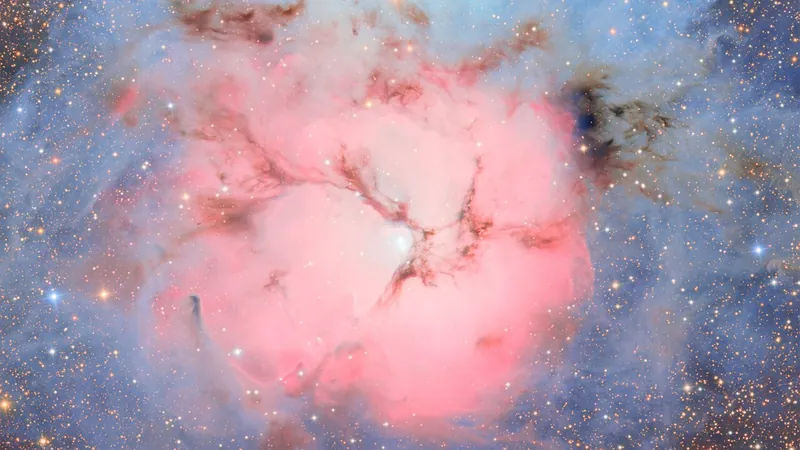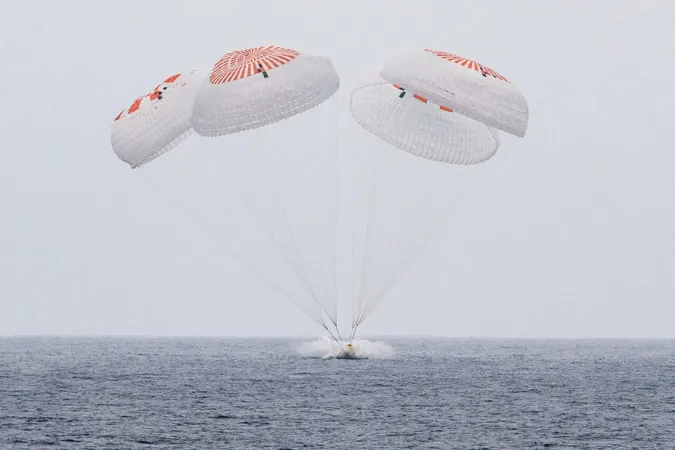
Cosmic Candy: Vera C. Rubin Observatory Unveils Stunning Trifid Nebula Image!
2025-06-29
Author: Mei
Experience the Cosmos Like Never Before!
This week marked a monumental moment in astronomy with the unveiling of breathtaking images from the Vera C. Rubin Observatory in Chile. Among these groundbreaking snapshots is a dazzling view of the Trifid Nebula, also known as Messier 20, presented in stunning detail like never before.
What Makes the Trifid Nebula So Unique?
The Trifid Nebula is a striking cloud of gas and dust, embodying three distinct elements, which is reflected in its name—"trifid" meaning split into three parts. It features vibrant pink hues from emission nebulae, which are clouds of ionized gas emitting their own light, juxtaposed with brilliant blue hues from reflection nebulae, where nearby stars' light scatters through gas and dust—similar to how streetlights illuminate fog. The image is further enriched by dark regions that reveal intricate dust lanes and nebulas, creating a breathtaking tapestry of star clusters.
A Dynamic Birthplace for Stars!
The Trifid Nebula isn’t just a pretty picture; it's a bustling galactic nursery where new stars are born. These stellar births generate intense radiation, sculpting the gas into the enchanting shapes we see in the new image.
An Unprecedented Cosmic Exploration!
Captured over four nights in May 2025, this jaw-dropping photo was compiled from 664 exposures using the 3,200-megapixel Legacy Survey of Space and Time (LSST) Camera, installed on the impressive 8.4-meter Simonyi Survey Telescope. For the next decade, this dynamic duo will survey the Southern Hemisphere's night sky every three to four days, providing an unprecedented time-lapse of our universe.
A Pioneering Survey of the Universe!
In an ambitious endeavor, this decade-long survey aims to generate more data in one year than all previous optical astronomy combined. Early results are promising—over 2,100 new asteroids have already been discovered in just the first week! The Rubin Observatory is set to uncover unknown supernovae and potentially hazardous near-Earth objects, with each section of sky being imaged around 800 times throughout the project, including the mesmerizing Trifid Nebula.

 Brasil (PT)
Brasil (PT)
 Canada (EN)
Canada (EN)
 Chile (ES)
Chile (ES)
 Česko (CS)
Česko (CS)
 대한민국 (KO)
대한민국 (KO)
 España (ES)
España (ES)
 France (FR)
France (FR)
 Hong Kong (EN)
Hong Kong (EN)
 Italia (IT)
Italia (IT)
 日本 (JA)
日本 (JA)
 Magyarország (HU)
Magyarország (HU)
 Norge (NO)
Norge (NO)
 Polska (PL)
Polska (PL)
 Schweiz (DE)
Schweiz (DE)
 Singapore (EN)
Singapore (EN)
 Sverige (SV)
Sverige (SV)
 Suomi (FI)
Suomi (FI)
 Türkiye (TR)
Türkiye (TR)
 الإمارات العربية المتحدة (AR)
الإمارات العربية المتحدة (AR)